
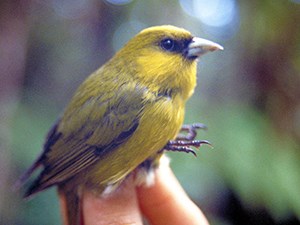
Image credit: USGS / Carter T. Atkinson
From the Editor
Ways to Meet a Changing World
Stressed forests. Songbirds at risk. Silver linings. How we talk to one another. The stories in this issue explore endings, beginnings, relationships, and our ever-present need for more information.
Podcasts

Podcast | Connections
Tuning in to Science: How to Reach Remote Communities through Radio
In vast, rural areas of the Southwest, where there’s no phone service or internet, radio rules. Science communicator Christopher Calvo, former host of “This Is the Colorado Plateau,” tells how community radio helped him share science over the airwaves (18 minutes).
By Christopher Calvo
Image (exclusive of podcast logo) © Christopher Calvo. Used by permission.
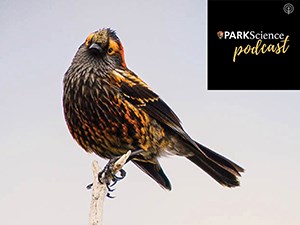
Podcast | Birds
Mosquitoes Are Key to Hawaiian Honeycreeper Survival
Birds Not Mosquitoes project partners Chris Farmer, Luka Zavas, and Ryan Monello discuss a modern mosquito-control technique to save Hawaii’s forest birds from imminent extinction. This project is the first time this technique has been used to protect animals (24 minutes).
By Jeri Stoller
Image credit: NPS
In Brief

Research | Night Skies
Strong Visitor Support for Steps to Limit Light Pollution
In a world where excess light is wiping out our views of the stars at a startling pace, parks can protect natural darkness. But do nighttime visitors support the changes parks must make to bring back dark night skies? We didn’t know until we asked them.
By Jessica Weinberg McClosky
Image credit: NPS / Michael Murphy
Picture This
The stories behind extraordinary images and videos from the practice of park science

These researchers used humor and art to share what they learned about teaming up with park interpreters and scientists.
Perspectives

Forests | Definitions
What Do We Mean by “Old Growth”?
Definitions underpin everything people do, and agreeing on them is essential for joint action. But how we define our nation’s forests is especially important because of their global and cultural significance.
By Ann M. Gallagher and Carolyn A. Copenheaver
Image credit: NPS
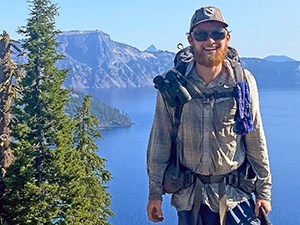
Hiking | Climate Change
Long-Distance Hikers Navigate the Hazards of a Changing Climate
For those who hike America’s thousand plus-mile national trails end-to-end, the benefits transcend the risks. But the effects of a warming world challenge even the most intrepid.
By Will Babb
Image © Will Babb. Used by permission.
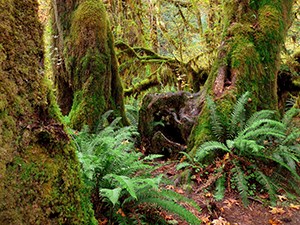
Forests | Monitoring
Early Detection Is the Best Protection for Old-Growth Forests
Despite dire evidence of rising tree death, researchers found resilience and hope deep inside western Washington's forests. But it will take 21st-century monitoring methods to keep that hope alive.
By Hazel Galloway, John Boetsch, Beth Fallon, and Marie Denn
Image credit: NPS
Features

Forests
When Wildfire Makes the Forest Understory the Star
Life on the forest floor is diverse, verdant, and plays a supporting role to the larger, flashier celebrities of the forest—its mature trees. But what happens when the trees don’t come back after fire?
By Nathan Kiel and Monica G. Turner
Image credit: NPS / Nathan Kiel
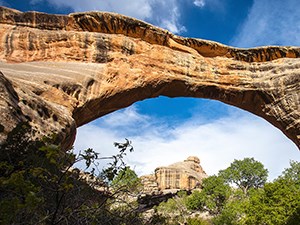
Geology
Unlocking Earth's Secrets, Layer by Layer
Those splendid rocks in our national parks aren’t just scenic wonders; they’re scientific and cultural treasures. A new geological inventory could help protect them.
By Tim C. Henderson, Vincent L. Santucci, Tim Connors, and Justin S. Tweet
Image credit: NPS
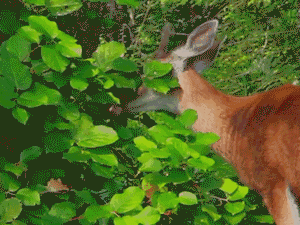
Forests
Eastern Parks Reduce Herds to Benefit Forests, Deer, and People
National parks protect a small but critical part of eastern U.S. forests. They’re now responding to an accelerating crisis as overabundant white-tailed deer coincide with a profusion of invasive plants.
By Megan Nortrup
Image credit: NPS
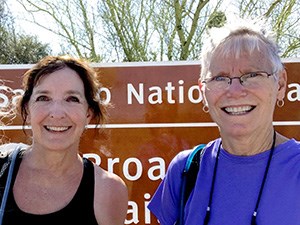
Citizen Science
The Devoted People behind Big Data in National Parks
Citizen science volunteers collect massive amounts of crucial scientific information. They gather it from sources as varied as oceans, mountainsides, and historic archives. Smart new tools are making their contributions even more powerful.
By Don Swann
Image credit: NPS

Air Quality
How to Assess Air Pollution's Impacts on Forests
The interconnectedness of living things is evident in a forest, where lichens act as pollution alarm clocks, and soil fungi help trees survive. Scientists studied just four types of organisms in the national park forest ecosystem to gauge its health.
By Mike Bell, Emmi Felker-Quinn, and Ksienya Taylor
Image credit: NPS / C. Keith
About This Issue
Last updated: August 30, 2024
